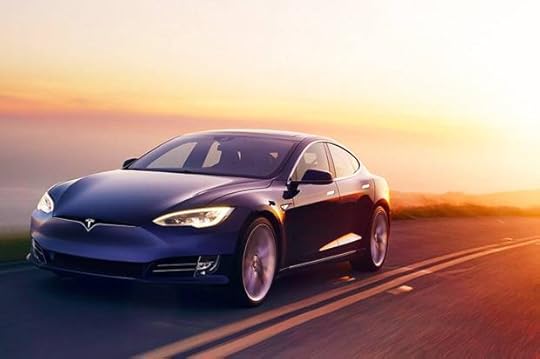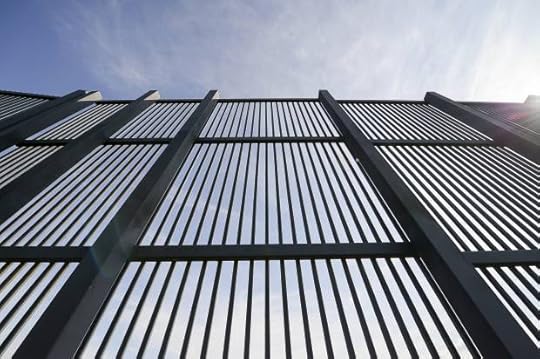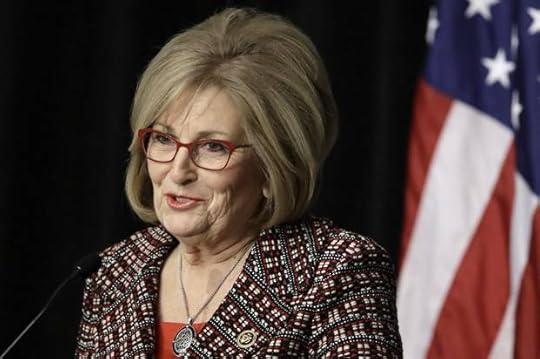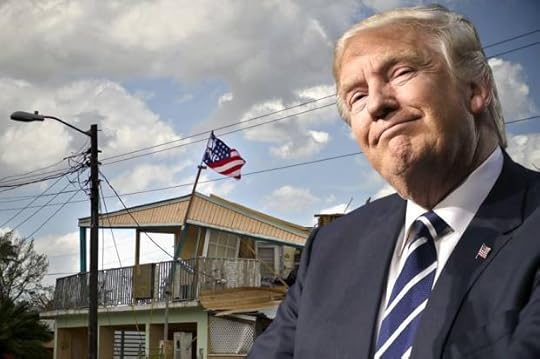Helen H. Moore's Blog, page 60
May 29, 2018
A Tesla in Autopilot mode just crashed into a police car

Tesla
An unidentified driver's Tesla sedan crashed into a parked police vehicle in Laguna Beach, California, on Tuesday morning, while the car was cruising in semi-automated "Autopilot" mode. Nobody was in the parked vehicle when the crash happened.
According to the Los Angeles Times, the collision happened at 11:07 am (PST) at 20652 Laguna Canyon Road. The driver suffered minor injuries.
"Thankfully there was not an officer at the time in the police car," Laguna Police Sgt. Jim Cota told the LA Times. "The police car is totaled."
Cota noted that last year a similar incident occurred — raising questions around the safety of Tesla's Autopilot feature.
"Why do these vehicles keep doing that?" Cota said to the LA Times. "We're just lucky that people aren't getting injured."
Tesla responded to the LA Times report, casting blame on the driver.
"Tesla has always been clear that Autopilot doesn't make the car impervious to all accidents, and before a driver can use Autopilot, they must accept a dialogue box which states that 'Autopilot is designed for use on highways that have a center divider and clear lane markings,'" a Tesla spokesperson said in an email.
Tesla’s Autopilot mode has been activated during a number of collisions over the last couple years.
In May 2016, a driver of a Tesla Model S electric sedan was killed when the car, in autopilot mode, crashed into a tractor-trailer. In March 2018, a Tesla Model S crashed in California; reports stated it was also using Autopilot at the time of the crash.
Most recently, in Northern Greece, a driver of a Tesla Model 3 claimed the car's autopilot malfunctioned before he got into a crash. Fortunately, no injuries were sustained.
Such news does not bode well for Tesla CEO Elon Musk. Following the March 2018 crash in California, Tesla released two updates reiterating their commitment to passenger safety, and claimed that Autopilot can actually save lives.
The blog post stated:
Over a year ago, our first iteration of Autopilot was found by the U.S. government to reduce crash rates by as much as 40%. Internal data confirms that recent updates to Autopilot have improved system reliability.
In the US, there is one automotive fatality every 86 million miles across all vehicles from all manufacturers. For Tesla, there is one fatality, including known pedestrian fatalities, every 320 million miles in vehicles equipped with Autopilot hardware. If you are driving a Tesla equipped with Autopilot hardware, you are 3.7 times less likely to be involved in a fatal accident.
The steep consequences of ABC’s bet on Roseanne Barr

AP/Richard Shotwell
For a company that has built its multibillion dollar brand on animated features based on fairy tales, it’s a little surprising that Disney isn’t up on its fables. One that could have come in handy is that classic of unknown origin about the scorpion and the frog. You know it, right? It’s a fun bit: A scorpion asks a frog if it can ride on its back to cross a river, and promises the frog it won’t sting him.
Midway through the journey, sure enough, the bug delivers a venomous poke to the amphibian, ensuring both will drown. When the frog asks why, the scorpion replies that stinging is in its nature.
Today, Disney-owned ABC is the frog flailing before millions after Roseanne Barr did the inevitable, delivering her sting by way of a racist tweet posted around 2:45 a.m. that has since been deleted. This time she described Valerie Jarrett, senior adviser to former President Barack Obama, as a combination of the Muslim Brotherhood and the "Planet of the Apes.”
The resulting furor led ABC to cancel its revival of Barr’s show “Roseanne,” confirmed in a statement from the network’s entertainment president Channing Dungey. “Roseanne's Twitter statement is abhorrent, repugnant and inconsistent with our values, and we have decided to cancel her show.”
Disney CEO Robert Iger co-signed on to Dungey’s statement with a tweet of his own:
From Channing Dungey, President of ABC Entertainment: "Roseanne's Twitter statement is abhorrent, repugnant and inconsistent with our values, and we have decided to cancel her show."
There was only one thing to do here, and that was the right thing.
— Robert Iger (@RobertIger) May 29, 2018
ICM Partners talent agency also announced that it has dropped her as a client. This stands to be a very costly decision for Disney and ABC. “Roseanne” returned to a viewership of 18 million in overnight ratings, an astronomical number in today’s Peak TV climate and even more so for a network comedy.
Though its numbers came back down to Earth afterward, the show still pulled more than 10 million viewers per episode by the end of the season, making it ABC’s most successful scripted series. Only two weeks ago ABC made “Roseanne” and its star the focus of its upfront presentation to advertisers, complete with Barr serenading the Madison Ave. reps with a rendition of “My Way.”
ABC executives touted the revival’s popularity as the foundation of the network’s resurgence. Across the industry, the victorious return of “Roseanne” has been credited for reviving the fortunes of the classic multi-camera format even though Chuck Lorre proved its resiliency years ago.
This is a long way of saying that doing the right thing in canceling “Roseanne” also stands to be a very expensive thing to do. And I’m not just referring to the potential economic ramifications. ABC is now facing a scramble to reconfigure its strategy for the new season and, potentially, to repair its relationship with other producers and a slice of its audience.
All because its star couldn't keep her social media habits under control. Or as author Ijeoma Oluo succinctly put it:
Literally all that Roseanne had to do was NOT call a black woman a monkey and she... just.... couldn't
Evidence mounts that vitamins might not do anything for your health

Getty/bixpicture
Vitamins are to health as music is to dancing — or at least that is what the multi-billion dollar vitamin and supplement manufacturing industry wants you to think. Yet in the past few years, medical research has started to question that tenet.
As many debates are in science and health, there are plenty of varying opinions, but according to a new study published in the Journal of the American College of Cardiology, the most popular vitamin and mineral supplements provide zero health benefits.
The study, which was conducted by researchers at St. Michael's Hospital and the University of Toronto, analyzed data and single randomized control trials published in English from January 2012 to October 2017. The systematic review found that multivitamins, vitamin D, calcium and vitamin C showed no benefit, or added risk, in the prevention of cardiovascular disease, heart attack, stroke or premature death.
The review looked at the aforementioned vitamins using the National Health and Nutrition Examination Survey data (from 1999 to 2012), which found supplement use in the U.S. reached a high in 2012. Multivitamins were taken by an estimated 31 percent of the population, vitamin D by 19 percent, calcium by 14 percent, and vitamin C by 12 percent, according to the report.
“We were surprised to find so few positive effects of the most common supplements that people consume,” said Dr. David Jenkins, the study's lead author, in an announcement. “Our review found that if you want to use multivitamins, vitamin D, calcium or vitamin C, it does no harm – but there is no apparent advantage either.”
The study found that niacin and antioxidants suggested there may be a small increased risk of death (!) from any cause for those taking said supplements.
However, taking folic acid alone, or B-vitamins with folic acid, might contribute to decreasing cardiovascular disease and stroke.
“These findings suggest that people should be conscious of the supplements they’re taking and ensure they’re applicable to the specific vitamin or mineral deficiencies they have been advised of by their healthcare provider,” Dr. Jenkins said.
This study echoes what others have suggested in the past, dating back to the 90s. Indeed, a study published in The New England Journal of Medicine in 1994 observed the effect beta carotene had on Finnish men who smoked. The results concluded that those who had consumed beta carotene for five to eight years were more likely to die from lung cancer or heart disease.
In 1998, researchers at the University of Leicester found that a Vitamin C supplement of 500 milligrams a day could damage a person’s genes. The article at the time, published in the British journal Nature, corroborated previous warnings. More recently, in 2013, a study in the Annals of Internal Medicine concluded that oral multi-vitamins and minerals did not reduce cardiovascular events in patients who had heart attacks.
Perhaps the most direct call to stop the vitamin craze originated in the Annals of Internal Medicine, in the 2013 editorial “Enough Is Enough: Stop Wasting Money on Vitamin and Mineral Supplements.” "Despite sobering evidence of no benefit or possible harm, use of multivitamin supplements increased among U.S. adults from 30% between 1988 to 1994 to 39% between 2003 to 2006, while overall use of dietary supplements increased from 42% to 53%," the authors note. Their editorial concluded:
β-carotene, vitamin E, and possibly high doses of vitamin A supplements are harmful. Other antioxidants, folic acid and B vitamins, and multivitamin and mineral supplements are ineffective for preventing mortality or morbidity due to major chronic diseases. Although available evidence does not rule out small benefits or harms or large benefits or harms in a small subgroup of the population, we believe that the case is closed— supplementing the diet of well-nourished adults with (most) mineral or vitamin supplements has no clear benefit and might even be harmful. These vitamins should not be used for chronic disease prevention. Enough is enough.
Yet the industry continues to grow. According to a McKinsey report, the supplement market in 2013 was valued at around $82 billion globally. In the U.S., which accounts for an estimated 28 percent of the global valuation, sales increased by an estimated $6 billion between 2007 and 2012. Pharmavite, which was a big player in the vitamin space, was acquired by Otsuka Pharmaceutical in 1989. Many companies who manufacture vitamins are part of the pharmaceutical industry.
So why, despite warnings from doctors and researchers, has the government failed to get involved? Pediatrician Paul Offit offered some insight in a New York Times editorial titled "Don't Take Your Vitamins.” He explained that in 1972 the F.D.A. announced a bill to regulate vitamin supplements — those that contained more than 150 percent of the recommended daily dosage — but the vitamin industry ultimately succeeded in destroying it.
More recently, the U.S. Preventive Services Task Force said there is insufficient evidence on benefits or harms of multivitamins to prevent cardiovascular disease or cancer. However, it does recommend not using beta carotene or vitamin E supplements to prevent cancer or cardiovascular disease.
Wilbur Ross becomes Trump newest Cabinet foe

Getty/Salon
President Donald Trump has once again undercut a member of his own administration in a particularly humiliating fashion. This time the victim was his Secretary of Commerce, Wilbur Ross.
According to a Politico report on Tuesday:
Trump himself has lashed out at Ross in Oval Office meetings, telling the man who once helped bail him out in Atlantic City that he’s “past his prime” and “no longer a killer” and trying to bench him from making trade deals, according to three people familiar with the comments. Despite being one of the administration’s leading protectionist voices early on, Ross was initially left off a May trade delegation to China led by Treasury Secretary Steven Mnuchin.
But now Ross is heading back to China in early June in hope of cutting some type of trade deal that delivers on Trump’s campaign promises to extract concessions from Beijing on behalf of American workers.
The report cited a number of reasons for the diminution in Ross' influence.
Although Ross had originally hoped to take the lead among administration officials on trade issues — a logical assumption given both his high-ranking cabinet post and the fact that, like Trump, Ross has been a longstanding critic of free trade policies — he was soon outpaced by Robert Lighthizer, Trump's choice for U.S. Trade Representative. Not only did Lighthizer effectively circumvent Ross when it came to trade issues, but Ross also hurt his standing with the president after he attempted to bring back two deals with China. One of those deals would have cut Chinese steel production and the other would have permitted Chinese cooked chicken to be imported to the United States in return for China importing America beef.
While Ross was proud of these achievements, Trump viewed them as nowhere near big enough, prompting him to humiliate Ross in front of other administration officials and informing Ross that he no longer wished for him to be involved in trade negotiations.
If this sounds familiar, that's because Trump has done this to previous cabinet officials.
In October Trump tweeted insults directed at Secretary of State Rex Tillerson over his stated desire to negotiate with North Korea (something Trump himself is currently in the process of trying to do).
"I told Rex Tillerson, our wonderful Secretary of State, that he is wasting his time trying to negotiate with Little Rocket Man... Save your energy Rex, we'll do what has to be done! Being nice to Rocket Man hasn't worked in 25 years, why would it work now? Clinton failed, Bush failed, and Obama failed. I won't fail," Trump tweeted.
Trump has also lashed out at Secretary of Homeland Security Kirstjen Nielsen, blaming her for his ongoing failure to curb undocumented immigration into the United States. The rant prompted Nielsen to draft a resignation letter, although she later decided not to submit it.
Perhaps most famously, Trump turned on a man who had once been one of his close friends, Attorney General Jeff Sessions. The bad blood between the two men arose after Sessions recused himself from the Russia investigation due to his own previously undisclosed contacts with Russian Ambassador Sergei Kislyak. In front of other members of his administration, Trump questioned Sessions' loyalty and accused him of both being weak and opening the administration up to the subsequent investigation from the newly-appointed special counsel. As The New York Times later reported:
Ashen and emotional, Mr. Sessions told the president he would quit and sent a resignation letter to the White House, according to four people who were told details of the meeting. Mr. Sessions would later tell associates that the demeaning way the president addressed him was the most humiliating experience in decades of public life.
Trump's public falling out with Ross, however, could have major consequences for the American economy. After more than eighty years of free trade economic policies, Trump is the first president to make open attempts to push America toward a more protectionist stance.
"Let me just say, from a policy and strategic standpoint, I think the president has it all wrong," Ed Gerwin of the Progressive Policy Institute told Salon last month:
He has this kind of very, in my mind, basic view that you can use tariffs to compel China to change their behavior. The problem is, there are legitimate concerns that we in the United States have about China's behavior, but most of those have to do with the unfair practices that China has engaged in with respect to trying to seize the industries of the future: Making it harder for American companies to sell high technology products in China, acquiring American technology through acquisitions in illegal means. Those are the kinds of things that are very troublesome with respect to China. And I don't really think that the president fully grasps that threat and instead is using tactics that, in my mind, are much more suited to the 1920s or 1930s, and they didn't even work back then.
Ross himself seemed to share this view, telling reporters at the World Economic Forum in Davos, Switzerland back in January that "there have always been trade wars. The difference now is U.S. troops are now coming to the ramparts." He later added, "Trade wars are fought every single day. Unfortunately, every single day there are various parties violating the rules and taking advantage."
Prior to Trump, the last president to be unequivocally protectionist was Herbert Hoover, the man who governed America before Franklin D. Roosevelt's presidency and the New Deal transformed how the federal government is expected to oversee the economy. Despite running a very controversial campaign in 2016, Trump's anti-trade rhetoric was one of the few issues that united Americans across ideological and other demographic lines, a fact that he used to justify hiring anti-trade policy advisers to important economic positions. Considering that the Commerce Secretary is traditionally one of the most powerful individuals in that group (if not the most powerful), it remains to be seen whether Trump's sidelining of Ross will hinder his ability to achieve one of his signature policy goals — that is, fixing trade agreements that he has regularly characterized as faulty.
Trump's new top economic adviser
More on Larry Kudlow, Trump's Director of the National Economic Council.
Trump’s border wall threatens nation’s biodiversity

Jason Hoekema/The Brownsville Herald via AP
This article originally appeared on Massive

Currently, the United States and Mexico are separated at the San Diego County line by two to three layers of border fences with an access road between them. The primary fence was built in the 1990s and a permanently lit, secondary fence, built in 2008. Neither of these projects included environmental impact studies before, during, or after they were completed. Scientists who conduct research in the area say that the construction impacted many rare plants and animals, including all but one of the area’s Shaw’s Agave plants, which grow here and only one other place in the country. Researchers were able to relocate several rare plant species, but only with limited success; the plants were not reintroduced to their original location, and the likelihood of repeat disturbance along the border is high.
Now, as these borderlands are just beginning to heal, we are bracing for construction of a new barrier. This new border wall will replace the fences; prototype designs suggest that it will be solid, and much deeper underground than the current structures, stopping any remaining natural movement of seeds, pollen, insects, and a plethora of small animals such as lizards, snakes, mice and other mammals through the fence.
In addition to human rights and civil liberties obstructions, this solid barrier will artificially fracture the area’s plant and animal populations, home to the greatest biodiversity in the nation. Hundreds of these species are rare, and dozens are threatened or endangered.
The state of California and environmental groups have been fighting hard against the Trump administration’s complete disregard of dozens of environmental laws while rushing to begin the border wall project. Unfortunately, US District Court Judge Gonzalo Curiel recently ruled that the Trump Administration did not abuse its power by waiving environmental laws during the rush to start the border wall project in San Diego County. This decision has allowed the project to continue despite scientific experts pleading for environmental protections and warning of dangers to come. As construction proceeds, it’s vital to include environmental protections for this unique ecosystem.
This physical barrier will not only negatively impact this one-of-a-kind environment, but also the scientific research occurring on both sides of the wall. This research is critical for protecting the rare plants, wildlife, and waterways which have otherwise been forgotten. Cross-border scientists already experience difficulties accessing their research areas, transporting critical specimens, communicating with each other, and interacting with border patrol agents. These hurdles end up not only affecting these researchers’ science, but also their safety: several researchers have told me that they have frequently been made to feel like criminals by US Customs and Border Protection when they were only doing their jobs. What chance does this ecosystem have if the only people protecting it are kept out, penalized, or ignored?
Maintaining relationships across the border is not only critical for scientists, but for our entire community. The lack of communication and environmental concern has created a sewage-pollution crisis at the Tijuana River estuary region, causing not only uninhabitable areas for wildlife but also many San Diego beach closings. The many threatened species require binational conservation plans and combined efforts to ensure their long-term survival. These are complex problems, and we need Mexico’s help to fix them. A fractured relationship across our border benefits no one and continues to hinder the scientific progress desperately needed for solving the border region’s pressing environmental and civil needs.
We need to push our representatives to support California Attorney General Xavier Becerra’s appeal to reverse Judge Curiel’s recent decision. And if the project is allowed to continue, we must demand that environmental impact studies be performed. In the future, there are many conservation actions (like preserving seeds from critical populations) that can be implemented. But right now, nothing is being considered except the construction of an impractical wall, which will harm current and future biodiversity around it: as this region warms with the changing climate, this wall would likely prevent adaptive movement of plants and animals northward. As scientists and allies, we must use our voices to communicate to our representatives the profound damage this border wall will have on the environment, our community, and scientific progress.
Top Trending
Check out the major news stories of the day
GOP congresswoman ignores guns, blames porn for school shootings

AP/Matt Rourke
There have been 23 school shootings this year so far, which averages out to more than once a week, and the blame is spread across a wide spectrum. While Republicans, including President Donald Trump, believe that untreated mental health issues are the problem, many young people plagued by school massacres have been steadily advocating for sensible gun control laws to curb easy access to firearms. But according to one Republican, porn is to blame.
Rep. Diane Black, R-Tenn., recently argued that the reason there have been so many massacres in schools is due to "pornography." That's what she told a group of local pastors in Clarksville, Tenn. last week during a listening session.
"It’s available on the shelf when you walk in the grocery store. Yeah, you have to reach up to get it, but there's pornography there," she added. "All of this is available without parental guidance. I think that is a big part of the root cause."
Black did not expand on what about porn causes gun violence, nor if she blames any specific porn category.
According to HuffPost, "Beyond naughty movies, Black said school shootings are on the rise because of the 'deterioration of the family,' mental illness and violent movies." Many politicians continue to attribute school shootings and other mass murders to mental illness, even though the data proves otherwise. "One study concluded that only about 22 percent of those who commit mass murders suffer from serious mental illnesses; the vast majority, or 78 percent, do not," U.S. News reported. "A 2016 research study concluded that the large majority of people with mental disorders do not engage in violence against others, and that most violent behavior is due to factors other than mental illness." More pertinent factors are social, cultural, and economic conditions and gun access, the research says.
This report added that if mental health issues were the primary indicator of violence than Western Europe would have similar gun violence rates as the U.S. Their mental illness rates match ours, but their murder rates do not. Instead, the correlation between gun ownership and gun violence is telling. "U.S. states that have significantly higher rates of gun ownership also have higher rates of homicides, suicides and 'accidental' gun deaths," according to U.S. News.
And Tennessee is considered a "gun friendly" state given its lax laws on firearms. In fact, one website that categorizes gun laws by state called Tennessee's gun control laws as "some of the least-restrictive in the United States." There is no mandatory waiting period to purchase firearms, however, the Tennessee Bureau of Investigation does add a $10 tax to conduct a background check. Also, a permit is not required to purchase a firearm either.
Perhaps Black missed the significant research connecting gun violence to gun access. But she made sure to congratulate the incoming president of the NRA. "Our constituents deeply cherish their 2nd Amendment rights protected under the U.S. Constitution, and we trust that those values will be upheld under his leadership," she said.
Pleased to congratulate Oliver North on being selected as the incoming President of the @NRA! The Constitution sets forth that gun ownership is a right for all law-abiding citizens, and we trust that our freedom will be protected under his leadership. https://t.co/TKofbS1r02
— Diane Black (@RepDianeBlack) May 15, 2018
Black is also a fundamentalist anti-choice activist and recently introduced the "Border Wall Trust Fund Act" to crowdsource public donations for Trump's border wall.
Season of the witch: How the word, and the concept, made a big 2018 comeback

Getty/ilbusca
For an administration that has made clear at every turn its contempt for marginalized women and the issues that most deeply concern them, it sure does love to identify with them. Why else would a president and his minions keep referring to themselves as the misunderstood village crones?
Taking a page from the Richard Nixon playbook, the tweeter-in-chief has of late developed a deep fondness for the phrase "witch hunt." On Tuesday morning, he deployed the phrase three times in a row — possibly while standing in front of a mirror and hoping to summon something exciting from the other side of the glass. Specifically, he referenced the "rigged Russia Witch Hunt," which keeps to his theme of the "phony Russia Collusion Witch Hunt" and the straightforward, no other words necessary "WITCH HUNT!"
The White House's embrace of phrase has trickled down. Rudy Giuliani has been doling it out since at least last fall, when he called the investigation into then-New Jersey Gov. Chris Christie a "partisan witch hunt." Earlier this month, he talked to local Washington station WJLA, and after asserting that "The president can’t be indicted" (which is debatable) he insisted, "There is a witch hunt." In April, press secretary Sarah Huckabee Sanders stated that the president believes that the Mueller probe is "a witch hunt," adding, "I’m not sure how we could be any more clear."
Much like the phrase "lynch mob," "witch hunt" in its modern usage seems a favorite of people who don't have a great grasp of its historical connotations there. For context, consider that both terms have also, in recent months, been applied to the #MeToo movement. Nothing like demanding accountability to incite cries of oppression.
Real witch hunts date back to ancient times and have been practiced all across the globe. The practice peaked in medieval Europe, when as many as 60,000 individuals were executed for the perceived crime. As BBC News magazine explains, accused witches were often "the convenient scapegoats for anything from a death in the village to the failure of crops. Individuals would often have been branded a witch after falling out with a neighbor…. Most would be poor and elderly." Three-quarters of them were women.
Witch hunts are still conducted in certain parts of the world today. In Gambia, former leader Yahya Jammeh reportedly regularly enforced them, targeting "poor, elderly farmers, forcing them to drink a hallucinogenic liquid before pressuring them into confessing to murders by sorcery." Over a span of seven years, suspected witches were subject to "kidnappings, beatings and forced confessions." Amnesty International confirms two deaths from the campaign, though the real number of victims is likely much higher.
Here in the United States, we associate witch hunts most closely with the infamous trials that took place in the Massachusetts Bay Colony in the late 17th century. As historian Rebecca Beatrice Brooks explains, "Many of the accused witches were outspoken women, Quakers, slaves, colonists with criminal backgrounds and/or prior witchcraft accusations or colonists who criticized the witch trials." Consider the first three women famously accused — "Tituba, a Caribbean slave; Sarah Good, a homeless beggar; and Sarah Osborne, an elderly impoverished woman." In all, 20 people were executed, and four more died while awaiting trial. None of them lived in gold towers or had reality shows.
The ignorant and manipulative are never going to stop being ignorant and manipulative -- and saying the same phrase over and over and over again is effective. It absolves both the originator of the smear and the people parroting him of having to come up with any real rebuttals or arguments. Just as happened with "fake news," "witch hunt" has now become a handy rallying cry for irritable trolls both on and off your social media feed. And why not? They are the flip sides of each other. Say something that disrupts a White House account of anything, even if that account itself is full of contradictions? FAKE NEWS. Ask a question about apparent falsehoods and inconsistencies? WITCH HUNT. It doesn't matter that it doesn't make sense. It doesn't matter that you might as well be screaming MANGOES AND ORANGES. All that matters is that it's insubstantial, and easily repeated.
The insistence of this administration to recast itself in the role of persecuted victim or outcast is galling to anyone who ever read "The Crucible" in high school, but the hyperbole is exasperating if you didn't. And it feels unbelievably pointed — an appropriation of state- and church-sanctioned violence and torture directed overwhelmingly at women, in particular women at the margins of society. "Who's the real victim now?" asks one of the most powerful men, consistently butt-hurt in the world as he tries to yank away programs that help women and the poor. (Spoiler: He thinks it's him.)
At least Jordan Peterson, subject of the wildest New York Times profile in recent memory, understands how the whole witch thing actually operates. In his sound-bite rich interview earlier this month with Nellie Bowles, the Canadian academic gave the witch population a shoutout by stating, "It makes sense that a witch lives in a swamp. Yeah. Why?” He expanded on the theme by explaining that "You say, ‘Well, there’s no such thing as witches.’ Yeah, I know what you mean, but that isn’t what you think when you go see a movie about them. You can’t help but fall into these categories. There’s no escape from them.” Then he gave his views on "enforced monogamy."
Peterson's bizarre notions about witches may appear on the surface to be just so much glorious word salad, but they make a perfect companion ideology to the "witch hunt" rhetoric rising like stale flatulence out of the White House. It's all about power. It's about the fear of power in the hands of anyone else, about the fear of having one's long held and entirely unearned privileges taken away. It's about the terror of anyone, anywhere, doing things that small-minded, fearful don't understand and can't control.
You need only look as far as "The Wizard of Oz" to know that witches get a bad rap. Witches are, just as often as not, the heroes. The healers. The truth-tellers. The ones who've paid the price for being different. If they're having a moment in the public conversation now, it's not because powerful men feel ostracized and victimized. It's because those men are scared. Scared that there are forces in the world stronger than they are. Scared that their hypocrisy will not sustain them. When the supposed commander in chief whines that he's the subject of a witch hunt, it's ludicrous not just because that's not how governing works. It's absurd because the witches would never have him.
Actions have consequences
Why there's no "witch hunt" in Washington
Michelle Wolf takes on Sarah Huckabee Sanders in Netflix premiere, triggers Fox News

Netflix
Michelle Wolf doubled down on her jokes about White House press secretary Sarah Huckabee Sanders on Sunday during the first episode of her new Netflix show, "The Break with Michelle Wolf."
"She has the Mario Batali of personalities," said Wolf during a segment titled "Sports Smash." The comedian began the segment by saying she wanted to discuss feminism and asked, "Do women have to support other women?"
"No, of course not! If we did, Hillary would be president and I don’t think she is," answered Wolf. She then brought up Gina Haspel, President Donald Trump's recently approved head of the CIA. "The first woman head of the CIA — that’s great! Who knew you could waterboard a glass ceiling until it broke?" asked Wolf, referencing the resistance Haspel faced from some in Congress over her beliefs surrounding the CIA's use of torture.
Wolf mentioned how her "best friend" Sanders had previously written a confrontational tweet, stating that any Democrat who disapproves of Haspel but claims to support women's empowerment is "a total hypocrite."
"There is no one more qualified to be the first woman to lead the CIA than 30+ year CIA veteran Gina Haspel," tweeted Sanders. "Any Democrat who claims to support women's empowerment and our national security but opposes her nomination is a total hypocrite."
There is no one more qualified to be the first woman to lead the CIA than 30+ year CIA veteran Gina Haspel. Any Democrat who claims to support women’s empowerment and our national security but opposes her nomination is a total hypocrite
— Sarah Sanders (@PressSec) May 5, 2018
"Well, if anyone's an expert on hypocrites, it's Sarah Huckabee Sanders," retorted Wolf. "And for the record, that was not a looks-based joke. That was about her ugly personality," she added, referencing a remark she made during the White House Correspondents' Dinner last month, which launched her feud with the press secretary. The comedian then drew comparisons between Sanders and the celebrity chef, who is currently under criminal investigation after allegations of sexual misconduct were made against him.
"Look, there's nothing anti-feminist about not supporting certain women," said Wolf.
Wolf's recent comments about Sanders seem to have struck a nerve with conservatives in particular.
On Tuesday morning, "Fox & Friends" spent a segment blasting Wolf as "vile" and "malicious" over her new remarks about Sanders and Haspel.
"Michelle Wolf represents a very angry, militant type of feminism that's very hypocritical," said RNC spokeswoman Kayleigh McEnany. "We see this on the left repeatedly, instead [the left] tears them down in a malicious, angry, vile way."
White House counselor Kellyanne Conway also came to Sanders' defense.
Appearing on Tuesday morning on "Fox & Friends," Conway said that she remembers "when comedians were funny."
"I hardly saw that, but all I can talk about is Sarah. I love working with her every single day here at the White House," said Conway. "She does a wonderful job representing the president and speaking to America on what is a very fast-moving agenda here."
"Gnerally speaking, not about that woman, but generally speaking, I’m old enough to remember when comedians were funny,” she added.
During the White House Correspondents' Dinner, Wolf took jabs at the press secretary among others, and compared her both to a macho softball coach and a character from "The Handmaid's Tale." But perhaps it was her joke focusing on Sanders' professional conduct that received the most backlash from outraged Trump supporters.
"I actually really like Sarah. I think she’s very resourceful," said Wolf at the event. "Like, she burns facts and then she uses that ash to create a perfect smoky eye. Like, maybe she's born with it, maybe it's lies."
The joke was received by some as a dig at the press secretary's physical appearance, and Wolf was quick to remind critics that her comments about Sanders at the event were focused on her tenure at the Trump White House.
"All these jokes were about her despicable behavior," Wolf tweeted in response to New York Times journalist Maggie Haberman, who praised Sanders for sitting through a routine that criticized her physical appearance and job performance.
Wolf has since said that she "wouldn’t change a single word that I said," at the event.
In response to Wolf's defense, Sanders said, "That evening says a whole lot more about her than it does about me ... I hope that [Wolf] can find some of the same happiness that we all have, because I think she may need a little bit more of that in her life because the rest of us here are doing great."
.@PressSec on #WHCD: "That evening says a whole lot more about [@michelleisawolf] than it does about me." pic.twitter.com/hsStsbPh8z
— Fox News (@FoxNews) May 3, 2018
Trump underestimated Hurricane Maria death toll by over 4,000: Harvard study

Getty/Salon
A recent study has concluded that at least 4,645 people died in Puerto Rico due to Hurricane Maria — a far cry from the death toll projected by President Donald Trump in October.
According to a study conducted by Harvard University andpublished in the New England Journal of Medicine, a loss of basic utility services on the U.S. commonwealth left the elderly and chronically ill without care in the chaos of last September's hurricane and its aftermath.
Much of Puerto Rico's infrastructure, including much of the electrical grid, continues to remain down despite the passage of more than half a year, while potable water and essential medical services are still unavailable for many island residents.
The news about the death toll in Puerto Rico is in stark contrast to the rosier picture of the island's situation that Trump has tried to depict since the hurricane struck. Speaking with Puerto Rican officials in October, Trump told them that they should proud that not as many people had died on the island as were suspected of dying due to Hurricane Katrina, according to CNN.
"Every death is a horror, but if you look at a real catastrophe like Katrina and you look at the tremendous — hundreds and hundreds of people that died — and you look at what happened here with, really, a storm that was just totally overpowering ... no one has ever seen anything like this," Trump said at the time.
After asking Governor Rosselló added that only 16 people were known to have died, Trump ran with it.
"16 people certified! Sixteen people versus in the thousands," Trump boasted. "You can be very proud of all of your people and all of our people working together. Sixteen versus literally thousands of people. You can be very proud. Everybody watching can really be very proud of what's taken place in Puerto Rico."
Since 1,833 are believed to have died in 2005 as a result of Hurricane Katrina, this means that Maria ultimately took more than twice as many lives as that storm.
Obviously, it stands to reason that, in a commonwealth with more than 3 million residents, more than 16 people would have died after a storm as wide-ranging and devastating as Hurricane Maria. Yet by early December, the official estimate had only been increased to 64, even though media reports and analyses had placed the number at over 1,000. Eventually, Governor Ricardo Rosselló decided it was necessary to receive outside help and asked George Washington University experts to look into the government's death certification process.
There are a number of different kinds of deaths that can occur as a result of a natural storm, which makes calculating them difficult even in situations where the government is doing its job competently. These can range from deaths caused by lack of access to medical services which otherwise would have saved lives to being hurt by flying debris or dying from exposure to the elements during or after the storm itself.
At the same time, there were factors unique to Puerto Rico that has made it especially difficult to accurately calculate the death total. As The Washington Post. :
The Harvard researchers reported that there are several reasons the death toll in Puerto Rico has been drastically underestimated. Every disaster-related death, they said, must be confirmed by the government’s Forensic Sciences Institute, which requires that bodies go to San Juan or that a medical examiner travel to the local municipality. And it can be difficult to track indirect deaths from a worsening of chronic conditions due to the storm.
The researchers said that the government of Puerto Rico stopped sharing mortality data with the public in December 2017.
“As the United States prepares for its next hurricane season, it will be critical to review how disaster-related deaths will be counted, in order to mobilize an appropriate response operation and account for the fate of those affected,” the authors wrote.
Trump has been harshly criticized for his lackluster response to the humanitarian crisis in Puerto Rico. As of March he had spent more public resources on helping Texas after Hurricane Harvey than he did on helping Puerto Rico after Hurricane Maria, including moving more quickly to provide assistance to residents of the Lone Star State than those in the Caribbean commonwealth. Trump also delayed in waiving the Jones Act, a law that had impeded the delivery of vital resources to the Puerto Rican people, and allowed that waiver to expire only weeks after putting it into place.
Trump has also been criticized for making racist comments in the aftermath of the hurricane. For instance, after the mayor of San Juan made a public plea for the president to devote more resources to helping Puerto Rico, Trump posted a series of tweets implying that the Puerto Rican people are lazy.
The Mayor of San Juan, who was very complimentary only a few days ago, has now been told by the Democrats that you must be nasty to Trump.
— Donald J. Trump (@realDonaldTrump) September 30, 2017
...Such poor leadership ability by the Mayor of San Juan, and others in Puerto Rico, who are not able to get their workers to help. They....
— Donald J. Trump (@realDonaldTrump) September 30, 2017
...want everything to be done for them when it should be a community effort. 10,000 Federal workers now on Island doing a fantastic job.
— Donald J. Trump (@realDonaldTrump) September 30, 2017
As talk show host John Oliver explained at the time, "You have got to hand it to Trump: anybody can say horribly racist things about Hispanic people on a golden escalator, but it takes real balls to do it while their fellow citizens are dying. Trump is basically saying: ‘When hurricanes are hitting our people, they’re not hitting our best, they’re killing poors, they’re killing lazies and some, I assume, have said nice things about me.’"
Trump also infamously pronounced the name "Puerto Rico" in a distinctly racist fashion in the month after Hurricane Maria devastated the island.
"Puerto Ricans feel American, but also feel Puerto Rican. They have a lot of loyalty to their culture, their island, their language. That as seen as, 'Therefore, they're not fully Americans,'" Professor Jose Moya of Barnard College told Salon in October.
Puerto Rico is being ignored. But what's the cause?
Salon talks with a Puerto Rican historian about why the plight of the island's inhabitants is being ignored.
Tricking drones with virtual reality to teach them to fly better, faster

AP/Alex Brandon
This article originally appeared on GearBrain.

[UPDATED] It sounds like a gaming fantasy come true. Researchers at the Massachusetts Institute of Technology (MIT) are putting drones into virtual reality (VR) spaces, teaching them to avoid barriers while flying fast — but not giving them anything to crash into as they speed.
Researchers were intrigued by drone races of recent years, where pilots fly quad-copters through obstacle courses at speeds of 120 mph and above. In these races, like those flow by the Drone Racing League, people make the decisions on how drones fly. MIT wanted to see if they could train their drones to handle themselves solo and autonomously.
The problem, of course, is that drones flying fast through hurdles, arches and doorways can crash, and then need to be replaced. So researchers wanted to figure out if they could train the drones with fewer crashes, while still giving them complicated courses to fly.
Enter VR. No, drones aren't physically strapping on VR goggles and taking to the air. (Drones don't have eyes.) Instead, researchers are programming the drones so they think they're in a living room or bedroom while they fly. They virtually see obstacles around them, but those impediments aren't really there.
Researchers are testing the new system, and their drones, in a new drone-testing space in Building 31 on MIT's campus, which just underwent a $52 million renovation. During testing, drones are being sent images faster than a human can register and see, at 90 frames per second. (For reference, movies are typically shown (and shot) at 24 frames per second.)
MIT has named its system "Flight Goggles," which is set to be shown at the IEEE's International Conference on Robotics and Automation in Brisbane, Australia this month. From there, after a couple more years of training, researchers hope to enter the drones into one of the competitive drone racing events, to see if a drone, flying solo, can beat any of the human pilots on its own.
Top Trending
Check out what's trending in the news right now.



